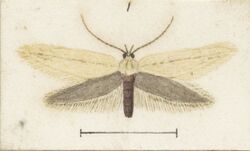Biology:Tingena maranta
| Tingena maranta | |
|---|---|

| |
| Male holotype | |
| Scientific classification | |
| Domain: | Eukaryota |
| Kingdom: | Animalia |
| Phylum: | Arthropoda |
| Class: | Insecta |
| Order: | Lepidoptera |
| Family: | Oecophoridae |
| Genus: | Tingena |
| Species: | T. maranta
|
| Binomial name | |
| Tingena maranta (Meyrick, 1886)[1]
| |
| Synonyms[2] | |
| |
Tingena maranta is a species of moth in the family Oecophoridae.[2] It is endemic to New Zealand and is found in the lower South Island. Adults of this species are on the wing from October until January. This species prefers grass or low herb habitat. Unlike its close relatives it does not inhabit native forest.
Taxonomy
This species was originally described by Edward Meyrick in 1886 using a specimen collected by Alfred Philpott in December at Invercargill and named Oecophora maranta.[3] In 1915 Meyrick discussed this species under the name Borkhausenia maranta.[4] In 1926 Alfred Philpott discussed and illustrated the genitalia of the male of this species.[5] In 1928 George Hudson also discussed and illustrated this species in his book The butterflies and moths of New Zealand.[6] In 1988 J. S. Dugdale placed this species within the genus Tingena.[2] The male holotype is held at the Natural History Museum, London.[2]
Description
Meyrick described this species as follows:
♂. 12 mm. Head, palpi, antennae, thorax, abdomen, and legs whitish-ochreous. Forewings elongate, narrow, costa moderately arched, apex round-pointed, hindmargin extremely obliquely rounded ; pale whitish-ochreous ; extreme base of costa dark fuscous : cilia pale whitish-ochreous. Hindwings grey-whitish ; cilia very pale whitish-ochreous.[3]
This species is pale in colouration and has distinctively narrow forewings.[6]
Distribution
This species is endemic to New Zealand and has been observed in Invercargill, as well as at Dunedin, Mount Ida, Central Otago and Mount Earnslaw / Pikirakatahi.[1][6]
Behaviour
Adults are nocturnal and are on the wing from October until January.[6][7]
Habitat and hosts
This species prefers to inhabit areas with grass or low herbs, and does not inhabit native forest.[6] Specimens have been collected in kānuka shrubland.[8] The larvae of T. maranta feed on leaf litter with specimens having been found in Poa litter.[8][9]
References
- ↑ 1.0 1.1 , pp. 462, Wikidata Q45922947
- ↑ 2.0 2.1 2.2 2.3 , pp. 103, Wikidata Q45083134
- ↑ 3.0 3.1 , pp. 791, Wikidata Q56010159
- ↑ , pp. 213, Wikidata Q63123349
- ↑ , Wikidata Q110157185
- ↑ 6.0 6.1 6.2 6.3 6.4 , pp. 263, Wikidata Q58593286
- ↑ Patrick, B. H. (January 1989). "Survey of Lepidoptera at Tara Hills Research Station" (in en). New Zealand Entomologist 12 (1): 42–48. doi:10.1080/00779962.1989.9722562. ISSN 0077-9962. http://ento.org.nz/nzentomologist/free_issues/NZEnto12_1_1989/Volume%2012-42-48.pdf.
- ↑ 8.0 8.1 GDH (July 2021). "New Zealand Aluminium Smelters Limited. NZAS Closure Preliminary Study. Environmental Study Report – Ecology". https://www.nzas.co.nz/files/3638_20220406135639-1649210199.pdf.
- ↑ Patrick, Brian H.; Lyford, Brian M.; Ward, John B.; Barratt, Barbara I.P. (December 1992). "Lepidoptera and other insects of the Rastus Burn Basin, The Remarkables, Otago" (in en). Journal of the Royal Society of New Zealand 22 (4): 265–278. doi:10.1080/03036758.1992.10420820. ISSN 0303-6758. Bibcode: 1992JRSNZ..22..265P. http://www.tandfonline.com/doi/abs/10.1080/03036758.1992.10420820.
Wikidata ☰ Q13860069 entry
 |



